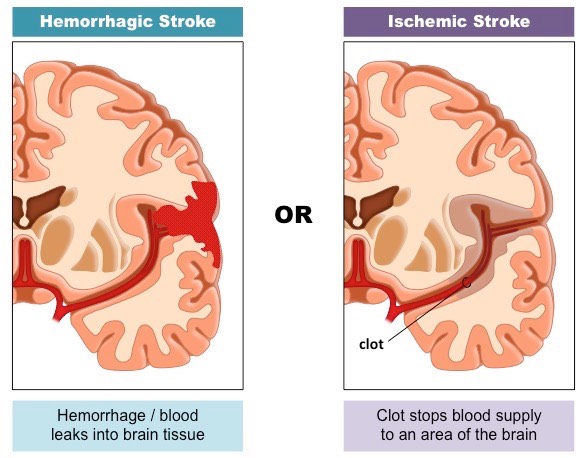A1 - Neural development
1/50
There's no tags or description
Looks like no tags are added yet.
Name | Mastery | Learn | Test | Matching | Spaced |
|---|
No study sessions yet.
51 Terms
What is embryogenesis
The development of a fully-formed organism from a fertilised egg
Where are all tissues derived from?
three initial germ layers (ectoderm, mesoderm, endoderm) formed via gastrulation
What is neurulation
The process by which a neural tube in embryonic chordates is formed
Neurulation process
Cells located in the outer germ layer (ectoderm) differentiate to form a neural plate
The neural plate then bends dorsally (towards the back), folding inwards to form a groove with a neural crest on either side
The infolded groove closes off and separates from the neural crest to form the neural tube
The neural tube will elongate as the embryo develops and form the central nervous system (brain and spinal cord)
The cells of the neural crest will differentiate to form the components of the peripheral nervous system
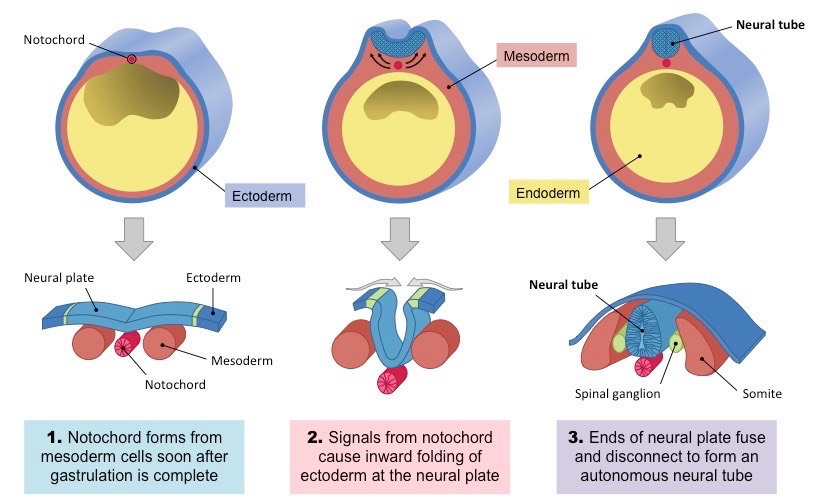
Xenopus and their use
genus of frog that possess robust embryos that can tolerate extensive manipulation
therefore they can be used as a suitable animal model for investigating the developmental stages of embryogenesis
Neurulation in a Xenopus Embryo
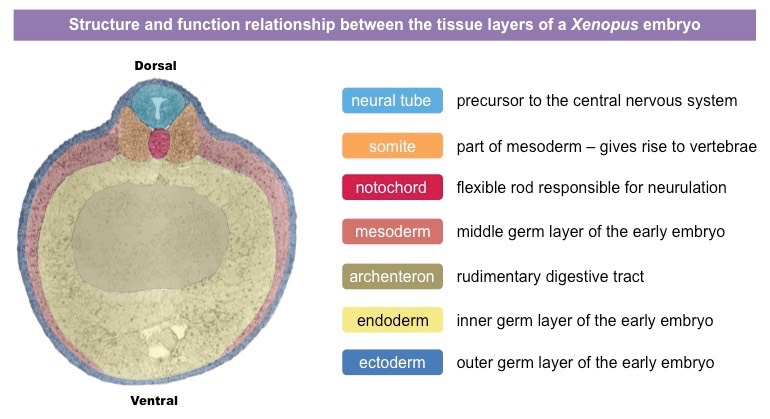
which areas does closure of the neural tube occur more slowly and faster in the embryo?
Closure of the neural tube occurs more slowly in the caudal (tail) region of the embryo,
while the area where the brain forms is well advanced in closure.
Spina bifida + effects
a birth defect resulting in the incomplete closure of the neural tube (and associated vertebrae)
The vertebral processes do not fuse, leaving the spinal cord nerves exposed and prone to damage
Normal vs spina bifida vertebrae comparison
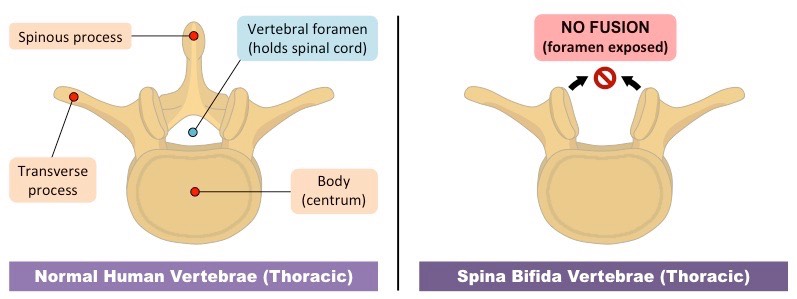
Spina bifida occulta
the splits in the vertebrae are so small that the spinal cord does not protrude (less severe/mild)
Spina bifida cystica
a meningeal cyst forms (meningocele) which may include the spinal elements (myelomeningocele) (less severe/mild)
Severe spina bifida - what happens
patients may typically suffer some degree of paralysis, as well as bowel and bladder dysfunction
Believed cause of spina bifida
Spina bifida is believed to be caused by a combination of genetic and environmental factors
The average worldwide incidence of the condition is ~1 in 1,000 births, however marked geographic variation occurs
Not having enough folate (folic acid)in the diet during pregnancy is believed to play a significant role in causing spina bifida
What does the neural tube contain
multipotent neuronal stem cells which can differentiate to form the different types of nerve cells:
neurons
glial cells
Neurons
are specialised nerve cells that conduct messages:
they can be sensory,
motor
or relay (interneurons)
Glial cells
provide physical and nutritional support for the neurons
roughly 90% of nerve cells in the brain are glial cells
How are neurons produced?
Via neurogenesis by progenitor neuroblasts
Do neurons regenerate?
Not usually.
Because most neurons survive for the lifetime of the individual and do not reproduce following embryogenesis
Certain brain regions may be capable of adult neurogenesis, but most of the nervous system is incapable of regeneration
Neuron production via neurogenesis

What must immature neurons do and why?
Immature neurons must migrate in order to adopt precise final positions that allow for the formation of neural circuitries
This migration process is critical for the development of brain and spinal architecture
2 processes via which neural migration may occur?
glial guidance or somal translocation
glial guidance
Glial cells may provide a scaffolding network along which an immature neuron can be directed to its final location
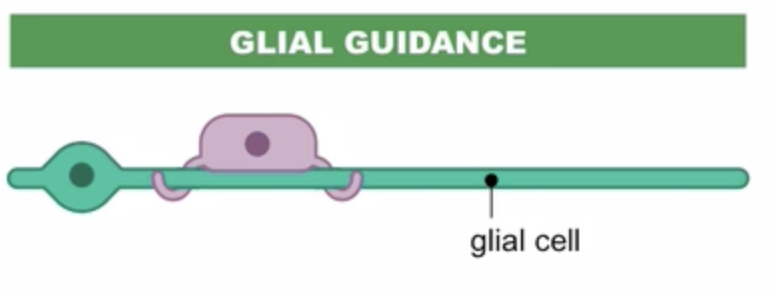
somal translocation
the neuron may form an extension at the cell’s perimeter and then translocate its soma along this length
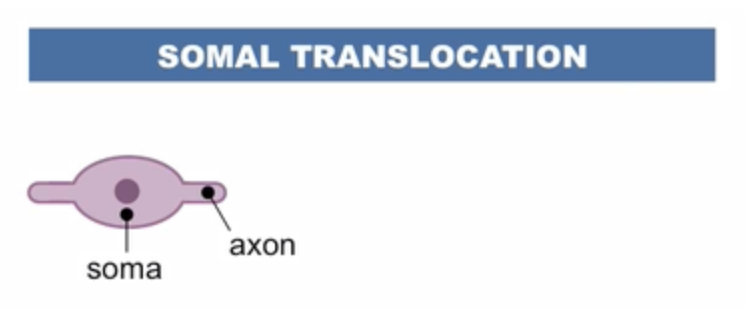
what does an immature neuron consist of
cell body (soma) containing a nucleus and cytoplasm
when will axons and dendrites grow from an immature neuron
Axons and dendrites will grow from each immature neuron in response to chemical signals from surrounding cells
Some axons may be quite short (within the CNS) but others may extend to other parts of the body (within the PNS)
what are filiopida
a growth cones at the tip of axons that contain highly motile growth filaments
extension of filiopida results
Extension of these filopodia causes the expansion of the internal cytoskeleton within the growth cone
this results in growth
what is the extension of filiopida controlled by - what does this allow the cells to do
chemical stimuli released from surrounding cells
These cells may release chemoattractant signals (grow towards) or chemorepellant signals (grow away)
Using these molecular guidance signals, axon growth cones may navigate long distances to reach specific targets

what is a synapse
a junction at which a neuron transmits a signal to another cell
Most synapses transmit chemical signals, although electrical synapses also exist
what will a developing neuron form… what will this allow
multiple synapses, creating a vast array of permutable communication pathways
what will a neuron form and with whawt within the central nervous system
Within the CNS, a neuron may form a synapse with another axon, dendrite or cell body (soma)
what will a neuron form within the peripheral nervous system
Within the PNS, a neuron may form a synapse with a muscle fibre (neuromuscular) or gland (neuroglandular)
neurosecretion
Some neurons may form a synapse with capillaries and secrete chemicals directly into the bloodstream (neurosecretory)
What is the role of synapses in the process of learning? how do neurons evolve / strengthen and weaken
During embryonic and early post-natal development, neurons form multiple synapses to maximize available connections.
As an organism matures, some synapses are used more frequently, strengthening those connections.
Conversely, synapses that are not used as often weaken and do not persist.
This process of strengthening and weakening certain neural pathways is essential for learning.
Neural pruning and how it works
Neural pruning involves the loss of unused neurons (by removing excess axons and eliminating their synaptic connections)
Infant vs adult brains no. of neurons and no. of synaptic connections
Infant and adult brains typically have the same total number of neurons (roughly 100 billion neurons in total)
However infant brains form vastly more synaptic connections (approximately twice the number found in adult brains)
purpose of neural pruning
to reinforce complex wiring patterns associated with learned behaviour
what influences neural pruning
Pruning is influenced by environmental factors and is
mediated by the release of chemical signals from glial cells
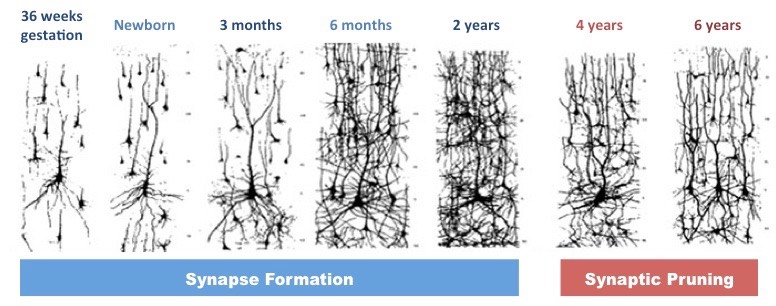
Synaptic Formation and Neural Pruning

Neuroplasticity
the capacity for the nervous system to change and rewire its synaptic connections
what does neuroplasticity enable
enables individuals to reinforce certain connections (learning) or avoid damaged regions
enables memory retention and learning
by which 2 mechanisms is neuroplasticity achieved
via two primary mechanisms
rerouting
sprouting
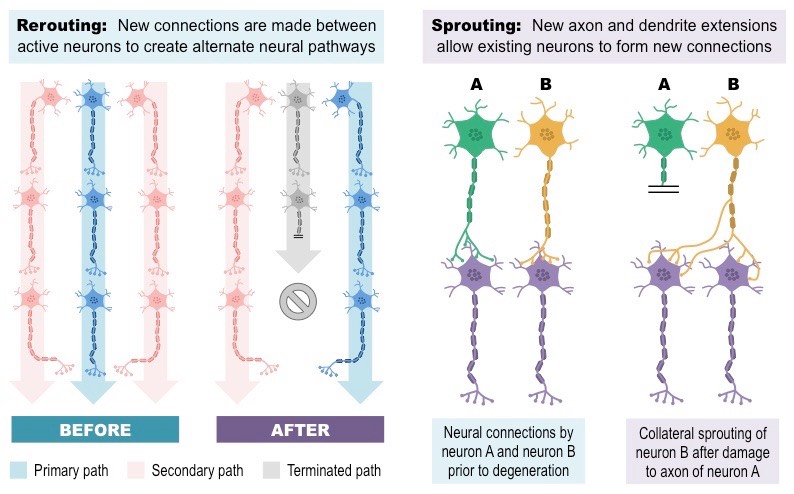
Rerouting
creating an alternative neural pathway by deleting damaged neurons and forming a new pathway between active neurons.
Sprouting
involves the growth of new axon or dendrite fibres to enable new neural connections to be formed
what is a stroke
is the sudden death of brain cells in a localised area due to inadequate blood flow
what do strokes result in
This results in the improper functioning of the brain, due to the loss of neural connections in the affected area
two main types of strokes
ischemic strokes
hemorrhagic strokes
ischemic strokes
Ischemic strokes result from a clot within the blood restricting oxygenation to an associated region of the brain
Hemorrhagic strokes
result from a ruptured blood vessel causing bleeding within a section of the brain
how may stroke symptoms be temporary and what is this a result of
Strokes symptoms may be temporary if the brain is able to reorganise its neural architecture to restore function
Following a stroke, healthy areas of the brain may adopt the functionality of damaged regions
This capacity for the restoration of normal function is made possible due to the neuroplasticity of the brain
types of strokes diagram
